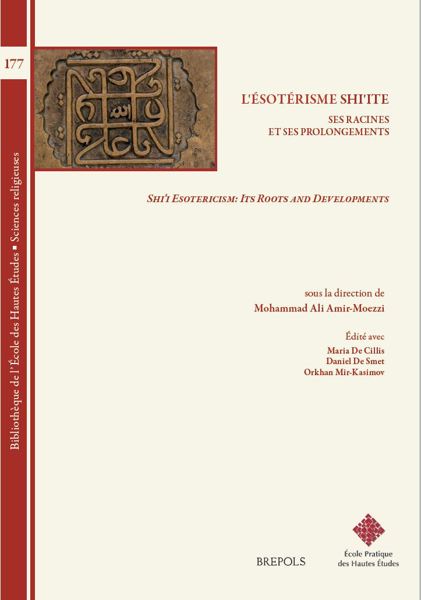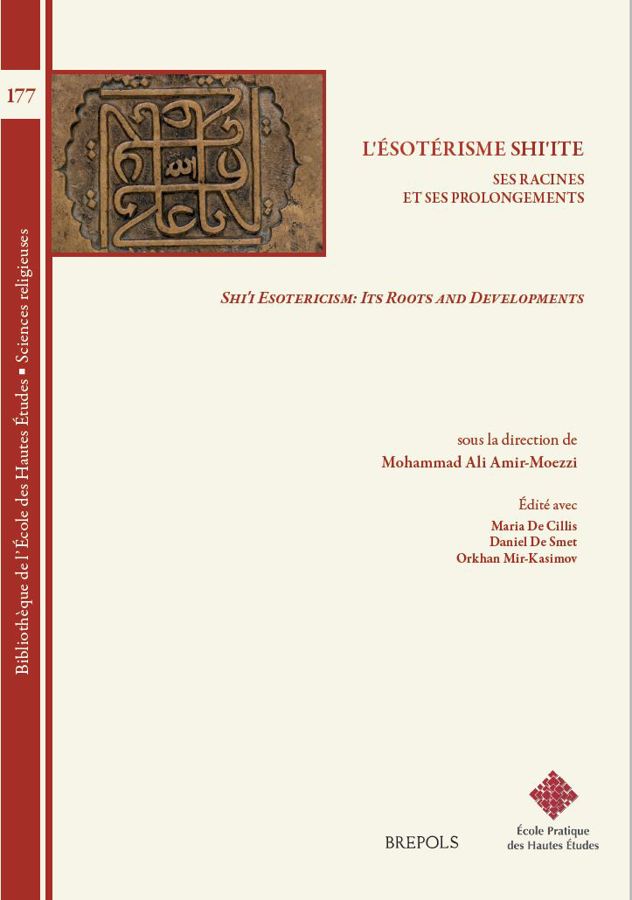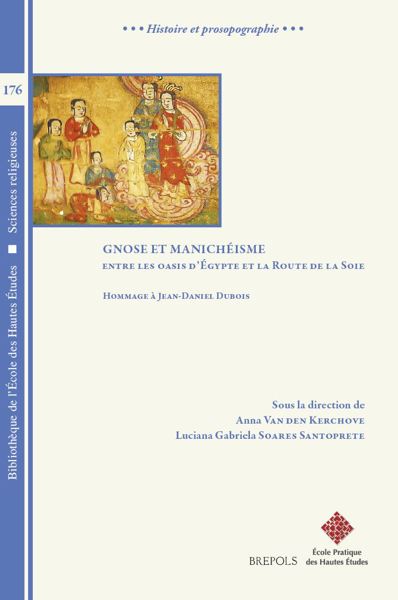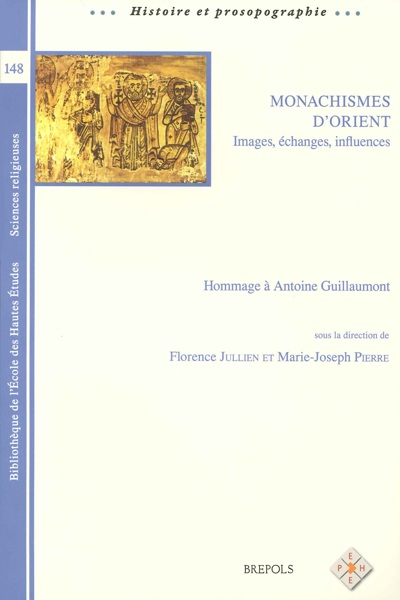
L'Ésotérisme shi'ite, ses racines et ses prolongements
Shi'i Esotericism: Its Roots and Developments
Mohammad Ali Amir-Moezzi, Maria De Cillis, Daniel De Smet, Orkhan Mir-Kasimov (eds)
- Pages: v + 870 p.
- Size:156 x 234 mm
- Illustrations:3 b/w
- Language(s):French, English
- Publication Year:2016
- € 115,00 EXCL. VAT RETAIL PRICE
- ISBN: 978-2-503-56874-4
- Paperback
- Available
- € 115,00 EXCL. VAT RETAIL PRICE
- ISBN: 978-2-503-56875-1
- E-book
- Available
Le shi'isme comme trait d'union entre les traditions spirituelles et ésotériques de l'Antiquité tardive et l'islam
« Le lecteur appréciera le caractère inédit de ces études, complétées par une biobibliographie résumée des auteurs et un index général. » (Christian Lochon, dans l’ Académie des Sciences d’outre-mer, Mai 2018)
« Nous sommes ainsi en présence d’un ouvrage qui (…) contient des études très savantes et apporte des éclairages très utiles sur des courants religieux peu connus, notamment les Nusayris de Syrie. » (Hocine Benkheira, dans Archives de sciences sociales des religions, 184, 2018, p. 178)
« En conclusion, Amir-Moezzi et ses collaborateurs offrent un long voyage à travers un ésotérisme chiite qui a montré sa grande capacité d’adaptation. » (Roberto Tottoli, dans Revue de l'histoire des religions, 1, 2019)
“This most welcome volume, brought to dazzling fruition by the leading scholar of Ithnā ʿasharī (“Twelver”) Shiʿism, offers the student of both Shiʿi and Sunni Islam a veritable cornucopia of riches concerning a topic still too little recognized and explored, particularly in English-speaking scholarly circles.” (Todd Lawson, in Journal of the American Oriental Society 139.3, 2019, p. 729)
« Le présent ouvrage illustre, en définitive, non seulement la richesse de l’histoire de l’ésotérisme shiʿite mais aussi son implication dans la formation et l’évolution culturelle de l’Islam. » (Wissam H. Halawi, dans Bulletin Critique des Annales Islamologiques, 34, 2020, p. 31)
“This impressive and welcome collection of articles and contributions in the field of Shiite studies addresses a wide range of themes and issues that, as made clear in the title, revolve around the central theme of Shiite esotericism (…)It is this reviewer’s opinion that this volume will stand for quite some time as a valuable work of reference for scholars and researchers interested not only in Shiite studies but also in Islamic religious culture and sciences, philosophy, theosophy, Sufism, alchemy, and occult sciences in general (…) In conclusion, Amir Moezzi, the editors, and the authors are to be commended for having put together a remarkable and stimulating piece of work that will undoubtedly appeal to scholars and researchers in Islamic studies.” (Marco Salati, in Der Islam, 97/1, 2020, p. 244-249)
Mohammad Ali Amir-Moezzi est Directeur d’études à l’Ecole Pratique des Hautes Etudes (Sorbonne) et Senior Research Fellow à l’Institute of Ismaili Studies (Londres). Daniel De Smet est Directeur de Recherche au Centre National de la Recherche Scientifique (Paris). Maria De Cillis et Orkhan Mir-Kasimov sont tous deux chercheurs à l’Institute of Ismaili Studies (Londres)
Together with the notion of secrecy, the core of Shi'i esotericism gravitates around the ẓāhir/bāṭin dualism. This dialectical relationship between the visible and the hidden, which has been inherited from Late Antiquity, buttresses the main doctrines of esoteric Shi'ism which include a dualistic worldview, doctrines of emanation, the contrast between the people of knowledge and of ignorance, the soterial nature of knowledge and of the Guide who possesses it, the two levels of the Scriptures, the need for hermeneutics, and initiatory knowledge and practices. It is true that the birthplace of Shi'ism was Iraq, which had been the central province of the Sassanid Persian Empire until the advent of Islam. This region and its main cities were home to the many intellectual and spiritual traditions of Late Antiquity, including various Jewish, Christian, Judeo-Christian, Mazdean, Manichean, Neoplatonic and Gnostic movements, with these traditions living on for several centuries after the advent of the religion of the Arabs. The articles in this collection, written by recognised scholars in the field, are divided into three sections covering a very wide period of time: the "prehistory" of these doctrines before Islam, early esoteric Shi'ism and its developments in both Shi'i and non-Shi'i Sufism, occult sciences and philosophy.
L’ésotérisme shi’ite a pour centre de gravité, à part la notion de secret, le couple ẓāhir /bāṭin. Cette dialectique de l’apparent et du caché, héritée de l’Antiquité tardive, se trouve à la base des principales doctrines du shi’isme ésotérique : vision dualiste du monde, doctrines émanationnistes, opposition entre les gens de la connaissance et ceux de l’ignorance, la nature salvatrice de la connaissance et du Guide qui la détient, le double niveau des Ecritures, la nécessité de l’herméneutique, savoirs et pratiques initiatiques…Il est vrai que la terre natale du shi’isme a été l’Irak, province centrale de l’empire perse des Sassanides avant l’islam. Cette région et ses principales villes ont été le siège de nombreuses traditions intellectuelles et spirituelles tardo-antiques : divers mouvements juifs, chrétiens, judéo-chrétiens, mazdéens, manichéens, néoplatoniciens, gnostiques… traditions qui continuèrent à vivre plusieurs siècles après l’avènement de la religion arabe. Les articles de ce recueil, écrits par des chercheurs confirmés, sont divisés en trois grandes parties recouvrant un très large arc chronologique : la « préhistoire » de ces doctrines avant l’islam, le shi’isme ésotérique proprement dit à l’époque ancienne, les prolongements de celui-ci dans le soufisme, les sciences occultes ou encore la philosophie, aussi bien shi’ites que non-shi’ites.
Mohammad-Ali AMIR-MOEZZI, Introduction
I. Les racines / Roots
Mohammad-Ali AMIR-MOEZZI, « Muḥammad le Paraclet et ʿAlī le Messie. Nouvelles remarques sur les origines de l’islam et de l’imamologie shi’ite »
Mushegh ASATRYAN & Dylan M. BURNS,"Is Ghulāt Religion Islamic Gnosticism? Religious Transmissions in Late Antiquity”
Daniel DE SMET, « Les racines docétistes de l'imamologie shi‘ite »
Jean-Daniel DUBOIS, « La figure du Prophète dans la religion manichéenne »
Moshe IDEL, « Hārūt and Mārūt: Jewish Sources for the Interpretation of the Two Angels in Islam”
Alain LE BOULLUEC, « La doctrine du vrai Prophète dans les écrits pseudo-clémentins »
Radu MARASESCU, « La question de la permanence du « platonisme » en Islam iranien selon Henry Corbin
Madeleine SCOPELLO, « Le thème de l’âme à la recherche du lieu de ses origines dans la gnose ancienne »
Michel TARDIEU, « L’oiseau d’or et les deux paons. Paraboles barlaamiennes de l’absence entre Mani et Ibn Bābūya »
Anna VAN DEN KERCHOVE, « Du Dieu au démiurge en passant par le Logos : la démiurgie dans les écrits hermétiques »
Jan VAN REETH, « La robe blanche des Serviteurs de Dieu. ‘Adī b. Zayd, le Coran, Bardésane et al-Muqanna‘ »
II. L’ésotérisme shi’ite ancien / Early Shi'i Esotericism
Hassan ANSARI, “Al-Ḥusayn b. Ḥamdān al-Khaṣībī and his al-Hidāya al-kubrā: Some remarks on Ḥadīth literature among the Nuṣayrīs”
Carmela BAFFIONI, “Esoteric Shī‘a in the Additions in Ancient Manuscripts of the Rasā’il Ikhwān al-Ṣafā’”
Maria M. DAKAKE, “The Concept of a Spiritual Elect in Shiite and Sufi Thought. Early Sources and Connections”
Maria DE CILLIS, “A Preliminary Study on the Significance of Qaḍāʾ and Qadar in the Eighth Chapter of al-Kirmānī’s Kitāb al-Riyāḍ”
Omid GHAEMMAGHAMI, ” “Except the Mawlā”.Notes on Two Hadiths concerning the Ghayba of the Twelfth Imam”
Heinz HALM, « Le « Livre des Ombres » et le mythe de la création »
Ehud KRINIS, “The Philosophical and Theosophical Interpretations of the Microcosm-Macrocosm Analogy in Ikhwān al-ṣafā’ and Jewish Medieval Writings”
Pierre LORY, « Esotérisme shi’ite et alchimie. Quelques remarques sur la doctrine de l’initiation dans le Corpus Jābirien »
Antonella STRAFACE, “The representation of al-Jadd, al-Fatḥ and al-Khayāl in the Ismaili literature: some examples and further remarks”
Bella TENDLER KRIEGER, “ʿAbd Allāh b. Sabaʾ and the role of the Nuṣayrī Bāb. Rehabilitating the Heresiarchs of the Islamic Tradition »
Roy VILOZNY, “What Makes a Religion Perfect: al-Ṣadūq’s (d. 381/991) Kamāl al-dīn Revisited”
Paul E. WALKER, “To What Degree was Classical Ismaili Esotericism based on Reason as Opposed to Authority?”
III. Les prolongements / Developments
Jean-Charles COULON, « L’ésotérisme shi’ite et son influence sur le corpus magique attribué à al-Būnī ».
Michael EBSTEIN, “Spiritual Descendants of the Prophet: al-Ḥakīm al-Tirmidhī, Ibn al-ʿArabī, and Ikhwān al-Ṣafāʾ on Ahl al-Bayt”
Christian JAMBET, « Ésotérisme et néoplatonisme dans l’exégèse du verset de la Lumière (Coran 24, 35) par Qāḍī Saʽīd Qummī »
Ahmet T. KARAMUSTAFA, “In his Own Voice: What Hatayi Tells us about Şah İsmail’s Religious Views ? »
Toby MAYER, “ ‘Mimetic Rivalry’ with Avicennism in Shahrastānī’s Esoteric Hermeneutics”
Orkhan MIR-KASIMOV, “Esoteric Messianic Currents of Islamic East Between Sufism and Shiʿism (7th/13th - 9th/15th Centuries)”
Lloyd RIDGEON, “ʿAlī ibn Abī Ṭālib in Medieval Persian Sufi-futuwwat Treatises”
Sajjad RIZVI, "Shiʿi Political Theology and Esotericism in Qajar Iran: The Case of Sayyid Jaʿfar Kashfī"
Monica SCOTTI, “Esoteric elements of the doctrine among the Ṭayyibī community: analysis of a treatise by Ibn al-Walīd (VI-VII/XII-XIII century)”
Yuri STOYANOV, "Gnosis and "Gnosticism" in Alevi and Bektasi Syncretism. Disputed Origins and New Directions for Research"
Mathieu TERRIER, « Anthropogonie et eschatologie dans l’œuvre de Muḥsin Fayḍ Kāshānī : L’ésotérisme shī‘ite entre tradition et syncrétisme »
Thierry ZARCONE, « La mort initiatique dans l’alévisme et le Bektachisme : de la ‘résurrection’ de ‘Alī à la pendaison de Ḥallāj »
Index général



